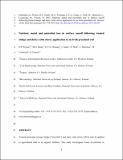| dc.contributor.author | Peyton, Dara P. | |
| dc.contributor.author | Healy, Mark G. | |
| dc.contributor.author | Fleming, Ger | |
| dc.contributor.author | Grant, Jim | |
| dc.contributor.author | Wall, David P. | |
| dc.contributor.author | Morrison, Liam | |
| dc.contributor.author | Cormican, Martin | |
| dc.contributor.author | Fenton, Owen | |
| dc.date.accessioned | 2015-10-09T09:26:14Z | |
| dc.date.issued | 2015 | |
| dc.identifier.citation | Peyton, D.P., Healy, M.G., Fleming, G.T.A., Grant, J., Wall, D., Morrison, L., Cormican, M., Fenton, O. (2015) 'Nutrient, metal and microbial loss in surface runoff following treated sludge and dairy cattle slurry application to an Irish grassland soil'. Science Of The Total Environment, 541 :218-229. | en_US |
| dc.identifier.issn | 0048-9697 | |
| dc.identifier.uri | http://hdl.handle.net/10379/5281 | |
| dc.description.abstract | Treated municipal sewage sludge ( biosolids ) and dairy cattle slurry (DCS) may be applied to agricultural land as an organic fertiliser. This study investigates losses of nutrients in runoff water (nitrogen (N) and phosphorus (P)), metals (copper (Cu), nickel (Ni), lead (Pb), zinc (Zn), cadmium (Cd), chromium (Cr)), and microbial indicators of pollution (total and faecal coliforms) arising from the land application of four types of treated biosolids and DCS to field micro-plots at three time intervals (24, 48, 360 hr) after application. Losses from biosolids-amended plots or DCS-amended plots followed a general trend of highest losses occurring during the first rainfall event and reduced losses in the subsequent events. However, with the exception of total and faecal coliforms and some metals (Ni, Cu), the greatest losses were from the DCS-amended plots. For example, average losses over the three rainfall events for dissolved reactive phosphorus and ammonium-nitrogen from DCS-amended plots were 5 and 11.2 mg L-1, respectively, which were in excess of the losses from the biosolids plots. When compared with slurry treatments, biosolids generally do not pose a greater risk in terms of losses along the runoff pathway. This finding has important policy implications, as it shows that concern related to the reuse of biosolids as a soil fertiliser, mainly related to contaminant losses upon land application, may be unfounded. | en_US |
| dc.format | application/pdf | en_US |
| dc.language.iso | en | en_US |
| dc.publisher | Elsevier | en_US |
| dc.relation.ispartof | Science Of The Total Environment | en |
| dc.rights | Attribution-NonCommercial-NoDerivs 3.0 Ireland | |
| dc.rights.uri | https://creativecommons.org/licenses/by-nc-nd/3.0/ie/ | |
| dc.subject | Biosolids | en_US |
| dc.subject | Nutrients | en_US |
| dc.subject | Metals | en_US |
| dc.subject | Rainfall simulator | en_US |
| dc.subject | Dairy cattle slurry | en_US |
| dc.subject | Civil engineering | en_US |
| dc.title | Nutrient, metal and microbial loss in surface runoff following treated sludge and dairy cattle slurry application to an Irish grassland soil | en_US |
| dc.type | Article | en_US |
| dc.date.updated | 2015-09-25T16:32:12Z | |
| dc.identifier.doi | doi:10.1016/j.scitotenv.2015.09.053 | |
| dc.local.publishedsource | http://www.sciencedirect.com/science/article/pii/S0048969715307130 | en_US |
| dc.description.peer-reviewed | peer-reviewed | |
| dc.contributor.funder | |~|Environmental Protection Agency (EPA)|~| | |
| dc.description.embargo | 2018-01-15 | |
| dc.internal.rssid | 9451908 | |
| dc.local.contact | Mark Healy, Room Eng-1038, Civil Engineering, Col Of Engineering & Informatics, Nui Galway. 5364 Email: mark.healy@nuigalway.ie | |
| dc.local.copyrightchecked | Yes | |
| dc.local.version | ACCEPTED | |
| nui.item.downloads | 548 | |


